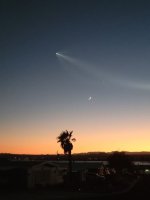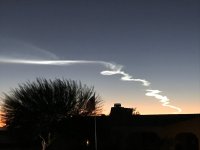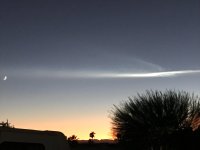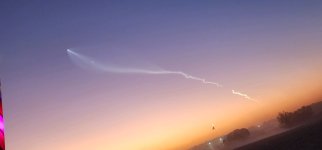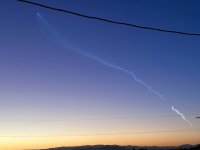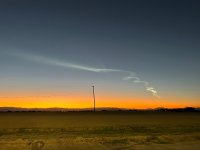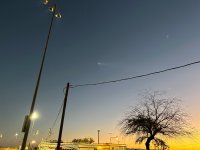- Apr 29, 2021
- 2,329
- 3,426
Evening Falcon Launch Thursday!
A Falcon 9 rocket is scheduled for launch Thursday evening (October 27) from Vandenberg SFB.
The rocket is slated to lift off from south base at 6:14:10 p.m. PDT. After climbing vertically for several seconds, the Falcon will begin a gradual turn, and head south-southeast and parallel the coast as it climbs into orbit. If the launch is successful, the Falcon 9 will place several Starlink internet satellites into orbit.
Liftoff occurs at Vandenberg SFB sunset, which means this is a daylight event for western California and northwest Mexico. The bright orange flame from the rocket's first stage could be visible to the unaided eye from as far away as Cambria, Mount Pinos, Newbury Park, and Malibu, Calif. Observers with an unobstructed horizon who know exactly where to look may see the event from venues more than 100 statute miles away.
People in very quiet locations in coastal Santa Barbara and Ventura Counties may hear a distant, muffled rumble from the launch several minutes after liftoff.
However, for observers in Nevada; Arizona; and Sonora, Mexico; liftoff occurs well after local sunset and may produce a nice display as the rocket's exhaust plume is illuminated by the Sun against an evening twilight sky.
For the best view of the launch, find a location with an unobstructed horizon towards the launch site and rocket's flight path. The best places may be southwest Lompoc and between Gaviota and Ventura.
Regardless of where you plan to view the launch, allow enough time to get there well before liftoff. Be careful when driving, especially on unfamiliar roads. After you arrive, be aware of your surroundings and possible hazards.
For launch status and countdown information, go to:
www.spaceflightnow.com
www.spacex.com
The Internet countdown feed may be delayed by several seconds. Rather than relying on the feed for launch cueing, use a GPS receiver or another source for the exact time. You can also set your watch to the exact time in advance using the National Institute of Standards and Technology (www.time.gov).
For a map of the launch hazard zones and rocket flight path, go to:
https://i.postimg.cc/sxKFRWvv/Calif28-31.jpg
For information on viewing Vandenberg rocket and missile launches, go to:
www.spacearchive.info/vafbview.htm

A Falcon 9 rocket is scheduled for launch Thursday evening (October 27) from Vandenberg SFB.
The rocket is slated to lift off from south base at 6:14:10 p.m. PDT. After climbing vertically for several seconds, the Falcon will begin a gradual turn, and head south-southeast and parallel the coast as it climbs into orbit. If the launch is successful, the Falcon 9 will place several Starlink internet satellites into orbit.
Liftoff occurs at Vandenberg SFB sunset, which means this is a daylight event for western California and northwest Mexico. The bright orange flame from the rocket's first stage could be visible to the unaided eye from as far away as Cambria, Mount Pinos, Newbury Park, and Malibu, Calif. Observers with an unobstructed horizon who know exactly where to look may see the event from venues more than 100 statute miles away.
People in very quiet locations in coastal Santa Barbara and Ventura Counties may hear a distant, muffled rumble from the launch several minutes after liftoff.
However, for observers in Nevada; Arizona; and Sonora, Mexico; liftoff occurs well after local sunset and may produce a nice display as the rocket's exhaust plume is illuminated by the Sun against an evening twilight sky.
For the best view of the launch, find a location with an unobstructed horizon towards the launch site and rocket's flight path. The best places may be southwest Lompoc and between Gaviota and Ventura.
Regardless of where you plan to view the launch, allow enough time to get there well before liftoff. Be careful when driving, especially on unfamiliar roads. After you arrive, be aware of your surroundings and possible hazards.
For launch status and countdown information, go to:
www.spaceflightnow.com
www.spacex.com
The Internet countdown feed may be delayed by several seconds. Rather than relying on the feed for launch cueing, use a GPS receiver or another source for the exact time. You can also set your watch to the exact time in advance using the National Institute of Standards and Technology (www.time.gov).
For a map of the launch hazard zones and rocket flight path, go to:
https://i.postimg.cc/sxKFRWvv/Calif28-31.jpg
For information on viewing Vandenberg rocket and missile launches, go to:
www.spacearchive.info/vafbview.htm


